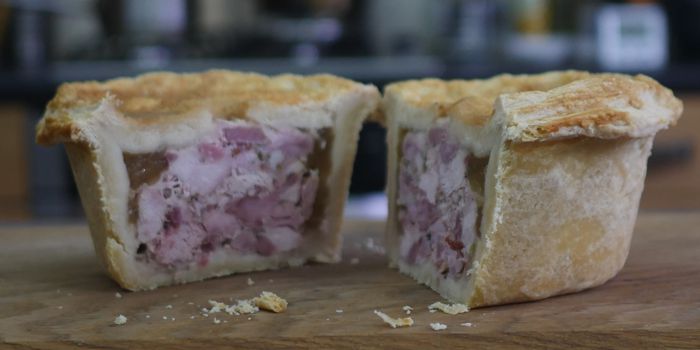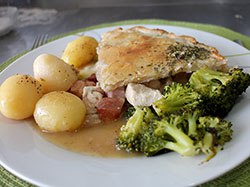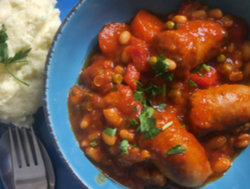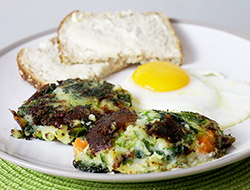
Rabbit and Bacon Pie
Introduction & method
I was inspired to make rabbit pie after watching a short film from 1932. Some of the techniques used in the film were absolutely not what I would normally do, but I decided to try it anyway. The film showed a pie with top crust only, boiled eggs included (why?) and jellied stock added at the end. This pie was served cold and completely fell apart when sliced. I decided that this was really 2 pies - a hot one and a cold one.

Joint and Debone the Rabbit
If you buy a whole rabbit, your butcher will likely have skinned and gutted it, but the heart, kidneys and liver may still be inside - remove these and use them for something else. Wash the rabbit, then remove the legs and cut the carcass in half. Rabbit bones are fairly easy to cut through. Then use a paring knife to remove as much meat as you can from the bones - it'll take a bit of time and patience. Put the meat in the fridge, and the bones in a stockpot or pressure cooker.
Make the Pastry
You can use all butter or all lard if you wish, but I think the mixture of both gives a better flavour. Cut your fats into small cubes. Mix the salt into the flour, then rub in the fat with your fingertips. You're aiming for a mix that looks like breadcrumbs. Add a small amount of water, stir it in, add more water, stir. Keep on adding water until the dough comes together in a ball - you don't want to add too much water.
Make the Filling
Hard-boil your eggs (7-10 minutes simmering). Plunge them into cold water and peel them.
Apart from the eggs, the filling for this pie is not pre-cooked. Cut the bacon into small strips. Mix all the ingredients (except eggs) together and add just enough water to cover everything.
Assemble the Cold Pie
The pie dish for the cold pie needs to be well-buttered inside. Roll out some pastry for the lid. Place the pie dish upside down on the pastry. If the dish has a rim, trim the pastry tightly up to that. If not, leave a margin of about 6mm (quarter inch) around the edge. Make a large hole in the centre for steam to escape and to pour the stock in at the end. Set aside. Roll out a larger piece of pastry and gently press this into the dish. Use a spare piece of dough to push the pastry right down into the base. Roughly trim off the excess. Spoon in half of the filling until it almost reaches the top. It's important that this pie is well-filled. Moisten the edge of the pastry with water and place the lid on it. Lightly press the lid and base together, then with a sharp knife, cut the edge so both pieces are aligned. Now, a thing from the old film that I've never seen before - with a sharp knife, make multiple horizontal cuts around the edge. It's a kind of feathering, and I'm guessing it's meant to make the shortcrust pastry look like puff. Glaze the top and edge of the pie with beaten egg.
Assemble the Hot Pie
Roll out the remaining pastry. Cut out the lid as before. Re-roll the leftover pastry into long strips about 25mm (an inch) wide. Moist the inside top edge of the dish and press one of these pastry strips onto it so that half is stuck to the dish and the other half is overhanging. The strips need to fill the entire rim. Now ladle in the pie filling, halve or quarter the boiled eggs and put them on top. Moisten the pastry rim with water and fix the lid on. Feather the edges as before. Make some holes in the pastry with a fork for steam to escape. Glaze the top and edge of the pie with beaten egg.
Bake the Pies
Because the filling is raw, these pies take a long time to bake. Preheat your oven to 180°C (356°F) for a fan/convection oven, 200°C (392°F) for a conventional one, gas 7. Put the pies in and bake for 25-30 minutes until the top is golden-brown. Then turn the heat down low: 120°C (240°F) for a fan/convection oven, 140°C (284°F) for a conventional one, gas 1. And bake for a further 2 hours. Told you it took a long time.
Make the Stock
While the pies are merrily baking, make the stock. If you have a pig's trotter, hopefully the butcher sliced it down the middle for you. We use a trotter, by the way, because it is extremely gelatinous and will make the stock set. If you can't get a trotter, you'll need to add gelatine at the end. Roughly chop your onion, carrot and celery and arrange them in a single layer on a baking sheet along with the marrow bone, the rabbit bones and the trotter. Drizzle oil all over them and pop the tray in the oven with the pies for half an hour - we're aiming for a bit of caramelization on the veggies and bones. After that, put them in a stockpot or pressure cooker, cover with water and add the herbs and pepper. Depending on how you choose to cook the stock, give it 30 minutes in a pressure cooker, or simmer for 2 hours in a stovetop pot with a lid on, or overnight in a slow cooker/crockpot.
When the stock is cooked, strain it through a colander into a saucepan, bring it to the boil and reduce by about half. Taste the stock and add salt if necessary. Strain the stock through a muslin cloth to remove any remaining sediment. If you didn't use a trotter, you'll need to make up some gelatine from powder or leaves (follow the manufacturer's instructions) and add that. When the stock has cooled, you'll probably get a layer of fat floating to the surface - remove this.
Jelly the Pie
If your stock has set to a solid jelly, gently warm it ti make it liquid but do not boil it. You may be able to fill the cold pie by inserting a funnel into the hole in the lid. If this doesn't work, use a flavour injector. Let the jelly set, then serve it up.
Ingredients & Info
FILLING
 1 whole rabbit
1 whole rabbit 200 grams bacon
200 grams bacon 1 tbsp fresh parsley
1 tbsp fresh parsley juice of 1 lemon
juice of 1 lemon 2 eggs
2 eggs 1-2 cup water
1-2 cup water salt & pepper
salt & pepperPASTRY
 450 grams plain (all purpose) flour
450 grams plain (all purpose) flour 125 grams butter
125 grams butter 125 grams lard
125 grams lard 1 tsp salt
1 tsp salt water
waterSTOCK
 rabbit bones
rabbit bones 1 pig's trotter
1 pig's trotter 1 medium onion
1 medium onion 1 carrot
1 carrot 1 stick of celery
1 stick of celery 2 bay leaves
2 bay leaves 1 tsp whole black peppercorn
1 tsp whole black peppercorn 1 tbsp fresh parsley
1 tbsp fresh parsley water
waterPrep time: 30 minutes.
Cooking time: 2 hours 30 minutes.
Total time: 3 hours.











